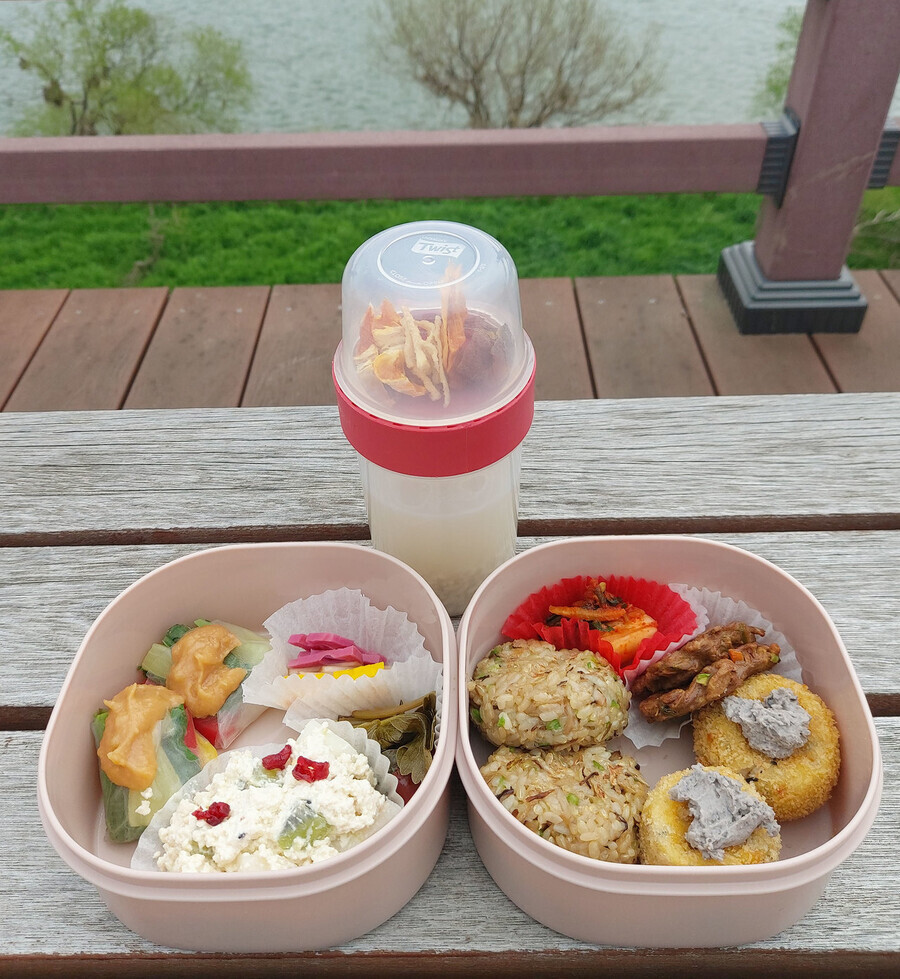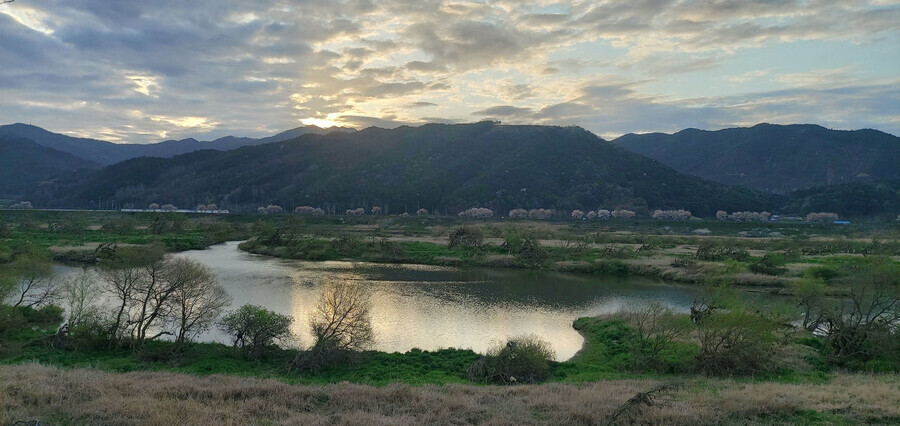hankyoreh
Links to other country sites 다른 나라 사이트 링크
[Travel] Floating along Seomjin River trail

Anyone who's gone trekking along a river or down a valley knows the feeling. There's a strange and almost subliminal compulsion to keep staring at the flowing water.
It's a little different than the catharsis felt at the seaside. The ocean waves shatter the walls around your heart, but the river water slowly carries away the knotted mass of emotions inside you.
You can't go wrong visiting the Seomjin River when green sprouts are poking up like hair after a buzz cut. The credits are already rolling on the cherry blossoms, but the leaves are just getting started.
The Seomjin River flows from north to south. It originates in Jinan, in North Jeolla Province, and passes Namwon and Gokseong to Gure, Hadong, and Gwangyang. I'd been to the Seomjin River at Gurye (in South Jeolla Province) and Hadong (in South Gyeongsang Province), which is famous for its cherry blossoms, but this was my first time to visit the county of Gokseong.
On May 1-2, I walked for 12-13 kilometers (7-8 miles) along the Seomjin River. For most of the walk, I was completely absorbed in the water of the river.

While I usually find my own way with a map, I opted for a trekking travel package this time. I was hooked by the price.
The overnight trip only cost 36,000 won (US$32), including accommodations at a guesthouse, two boxed meals, and 20,000 won (US$17) in local currency that could be spent like cash at restaurants and stores in the area. They even threw in souvenirs, snacks, and 1,000 won (US$0.9) to pay for the bus that would take me back to the starting point.
The package for this 12.6-kilometer (7.8-mile) trail walk along the Seomjin River is organized by Seomjin River Toad, a cooperative run by eight residents of Gokseong. It's one of the rural travel packages in Gokseong that are subsidized by Korea's Ministry of Agriculture, Food and Rural Affairs.
It turns out that the unreal price of 36,000 won for an overnight trip is possible because the Ministry and Gokseong County Office cover 70 percent of the expenses.
The goal is to promote trips that are as easy on the environment as they are on the pocketbook, in what's called "ecotourism." The trips are designed to be low-impact, benefiting both the natural ecosystem and local residents.
The boxed meals — made with produce grown in the area — are delivered to hikers and then picked up afterward. Handing out local currency helps support the local economy.
The organizers also take measures to ensure social distancing. A maximum of 15 people are allowed to sign up for the package, with no more than four people per group, and the various groups are allowed to explore the area on their own.
My trek began at 11 am on May 1 from Gokseong Voyager Lounge, a café in Gokseong Township. The path runs along a series of waterways: the Yeongun Stream, the Gokseong Stream, and the Seomjin River.
Cherry blossoms dotted the area around "train village," and two Indian spot-billed ducks enjoyed a friendly swim on the Gokseong Stream.
I walked along a bank beside the stream until I reached the Chimsil Wetlands Lookout, the designated lunch spot. My box meal was delivered by the Gokseong Voyager Lounge.
My lunch included two rice balls, two croquettes, kimchi, acorn pancakes, tofu salad, lotus roots, pickled hog fennel, and spring rolls. The dishes were prepared with taro roots, which are a specialty of Gokseong, and various crops harvested in the area. For a beverage, there was coffee and sikhe, a sweet rice concoction.
Sitting in a chair in the rest area, I gazed out at the Seomjin River while I wolfed down my meal.

During the monsoon season last summer, Gokseong suffered flood damage, and the wetlands were no exception.
The waters reportedly rose as high as the Chimsil Wetlands Lookout, completely submerging willow trees in the area. When the waters receded, the trees were bent, broken, and toppled.
But the next spring, leaves sprouted from willows that had been knocked down, with just their roots barely holding to the earth. Willows that had lost half their lush branches sent out new shoots, restoring balance.
Among the trees was a tiny willow that seemed to have just sprouted, reaching up nonchalantly toward the sky.
The sight of the wetland, with leaves returning after the flood, filled me with a mysterious sense of the sublime. It reminded me of people trying to rebuild their life after a period of adversity.
"You can see nature trying to get back on its feet at the Chimsil Wetlands following the flood damage last summer. There are more sandbars and pools now, which actually make more room for birds and aquatic plants," said 47-year-old Chu Seon-ho, president of Seomjin River Toad.
A total of three people took part in the walk that day. Choi Gwang-seok, 60, said that he had come from Gwangju after seeing a brief write-up in a local daily.
"I wanted to get some exercise and enjoy a walk along the Seomjin River," he said. "The flowing water and the wetland landscape are truly beautiful."
In November 2016, the Chimsil Wetlands became the first South Korean stream wetlands designated as a national protected area. They are seen as boasting superb biodiversity and ecological value.
They provide a habitat for a total of 665 known species. These include the Eurasian otter (Natural Monument No. 330) and white-tailed eagle (No. 243-4), both Class I endangered species. Class II endangered species include the leopard cat, Chinese pond turtle, Eurasian sparrowhawk, Eurasian hobby and upland buzzard.
The wetlands cover a total area of around 2,037,000 square meters (503 acres).

The Seomjin River flows out of the Chimsil Wetlands. We walked south, in the direction of Gurye. The course leads from the Chimsil Wetlands observatory over the wooden bridge and another metal bridge with holes bored into it, proceeding from there along the bicycle path at the river's edge.
All around the river were the landscapes of spring. On the green mountain the distance, white patches of hill cherry blossoms could be seen; near the river's side, tall trees glinted with light green leaves.
Along the water, people could be seen fishing by themselves and gathering clams. It seemed like spring all over, with the people riding their bikes in the breeze and a train resembling a steam locomotive that followed the cherry blossom trail down from Gokseong's "train village."
But most of the time, I looked out at the river water as I walked. It comforted me to watch its flow.
After some time, we passed the entrance to Dokkaebi Maeul, a forest activity center for young children that features over 1,000 sculptures of goblins from Korea and overseas, and Dugaheon, a cafe situated in a traditional Korean hanok building.
This meant we had almost arrived at our destination. From here, we would be passing over the swaying bridge on the Seomjin and heading back up the riverside for about 15 minutes. The path took us walking amid the river's greenery.
It's a setting where deep green vegetation stands side-by-side with trees that have been felled and strewn about by flooding. A county bus from a stop at our destination in Durye Village was available to take us back to our starting point in Gokseong.
Early the next morning, I headed back to the Chimsil Wetlands. I had been told that mist usually formed over the river around this time of day when the temperature difference between morning and afternoon was high. I looked forward to seeing the sunrise — and even a Eurasian otter, if I was lucky.
Dawn broke around 6 am. Not only was there no mist or otter to be seen, but even the sun was covered up by clouds. The waters were tinged with the light that managed to peek its way out from the clouds. The yellowish ripples glowed like stained glass.
Light also glinted off the leaves on the fallen trees. At that point, I began thinking about how precious those thin rays of light were to those trees.
" Staring Out at the Seomjin" travel diaryHow to Visit: The "Seomjin River' Mulmeong' Trail Walking" program is available by prior reservation through the Gokseong Voyager Lounge (Eumnae 18-gil 6, Gokseong Township, Gokseong County, South Jeolla Province, Tel: 061-363-5650). Reservations are available for between two and 15 people per day through May 25. Groups of up to four members are permitted to make reservations. The cost is 36,000 won per person, which includes a stay at a bed-and-breakfast or guesthouse and two meals (packed lunches). A local gift certificate worth 20,000 won and 1,000 won in cash for county bus costs are provided when you visit, along with souvenirs and snacks. See the Voyager Lounge website at blog.naver.com/and_gs (Korean only) for more information.
Additional Information:
The Gokseong Voyager Lounge office is located 10 minutes by foot from the Gokseong KTX train station. Admission to the Seomjin River Train Village (Gichamaeul-ro 232, Ogok Township, Gokseong County, Tel: 061-360-8379) is 5,000 won for adults. Tickets for the steam locomotives, which operate five times a day, are sold separately at a cost of 9,000 won (US$8) for an adult round-trip fare. Admission to Seomjin River Dokkaebi Maeul (Hogok Dokkaebi-gil 119-97, Godal Township, Gokseong County, Tel: 061-363-2953) costs 5,000 won (US$4) for an adult. To get there, walk for around one kilometer (0.6 miles) along the trail from the Dokkaebi Maeul entrance. Parking can also be accessed by car along a narrow forest road.
By Kim Seon-sik, staff reporter
Please direct comments or questions to [english@hani.co.kr]

Editorial・opinion
![[Column] Life on our Trisolaris [Column] Life on our Trisolaris](https://flexible.img.hani.co.kr/flexible/normal/500/300/imgdb/original/2024/0505/4817148682278544.jpg) [Column] Life on our Trisolaris
[Column] Life on our Trisolaris![[Editorial] Penalties for airing allegations against Korea’s first lady endanger free press [Editorial] Penalties for airing allegations against Korea’s first lady endanger free press](https://flexible.img.hani.co.kr/flexible/normal/500/300/imgdb/original/2024/0502/1817146398095106.jpg) [Editorial] Penalties for airing allegations against Korea’s first lady endanger free press
[Editorial] Penalties for airing allegations against Korea’s first lady endanger free press- [Editorial] Yoon must halt procurement of SM-3 interceptor missiles
- [Guest essay] Maybe Korea’s rapid population decline is an opportunity, not a crisis
- [Column] Can Yoon steer diplomacy with Russia, China back on track?
- [Column] Season 2 of special prosecutor probe may be coming to Korea soon
- [Column] Park Geun-hye déjà vu in Yoon Suk-yeol
- [Editorial] New weight of N. Korea’s nuclear threats makes dialogue all the more urgent
- [Guest essay] The real reason Korea’s new right wants to dub Rhee a founding father
- [Column] ‘Choson’: Is it time we start referring to N. Korea in its own terms?
Most viewed articles
- 1New sex-ed guidelines forbid teaching about homosexuality
- 260% of young Koreans see no need to have kids after marriage
- 3Months and months of overdue wages are pushing migrant workers in Korea into debt
- 4Presidential office warns of veto in response to opposition passing special counsel probe act
- 5[Column] Life on our Trisolaris
- 6S. Korea discusses participation in defense development with AUKUS alliance
- 7OECD upgrades Korea’s growth forecast from 2.2% to 2.6%
- 8Hybe-Ador dispute shines light on pervasive issues behind K-pop’s tidy facade
- 9Japan says it’s not pressuring Naver to sell Line, but Korean insiders say otherwise
- 10Opposition calling for thorough investigation into Pres. Park’s unelected power broker